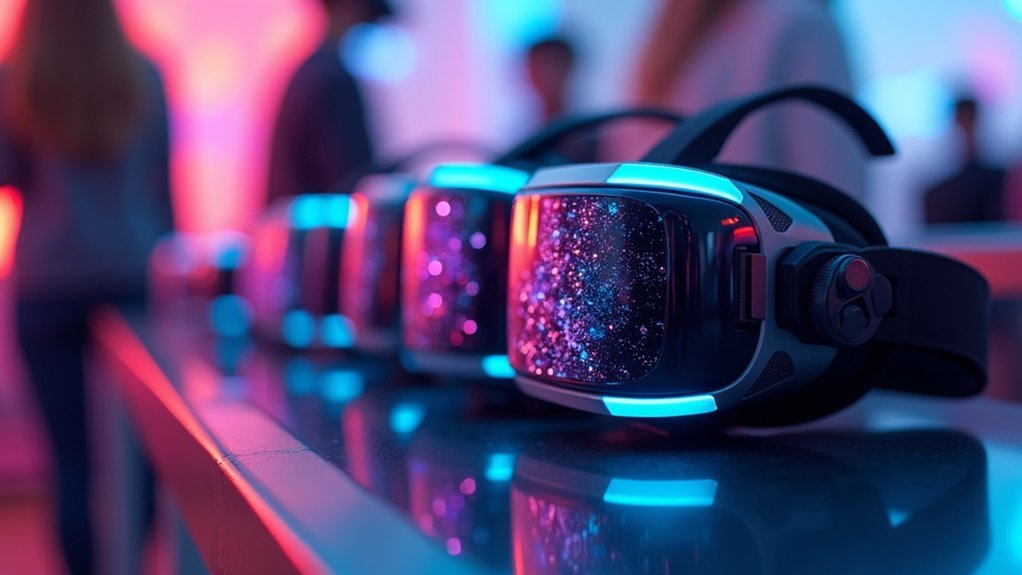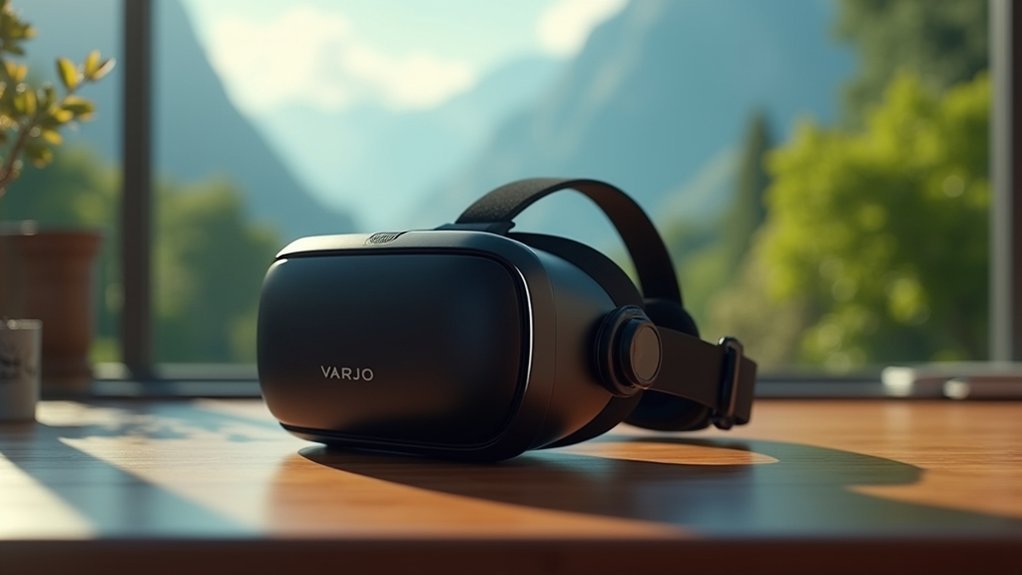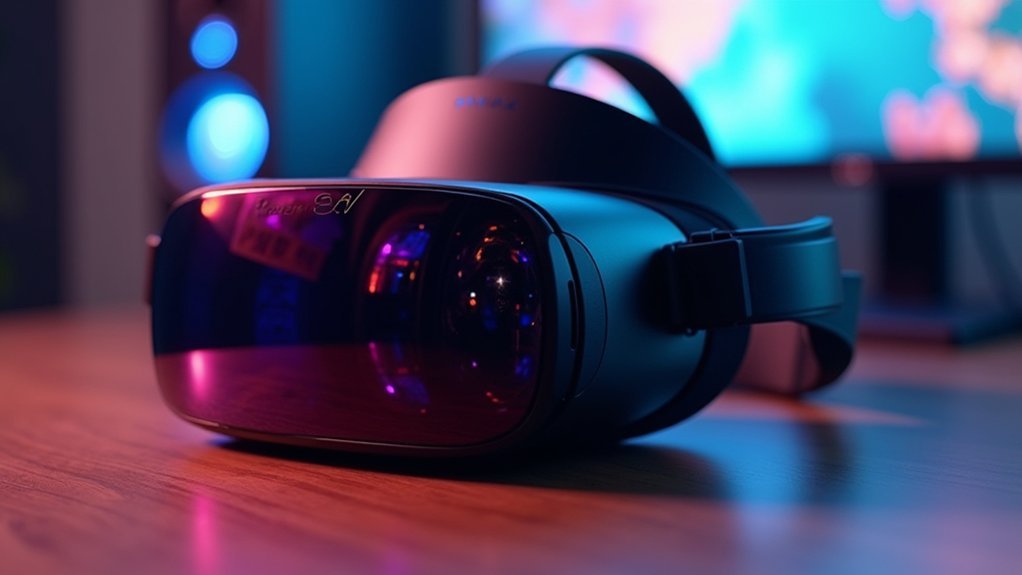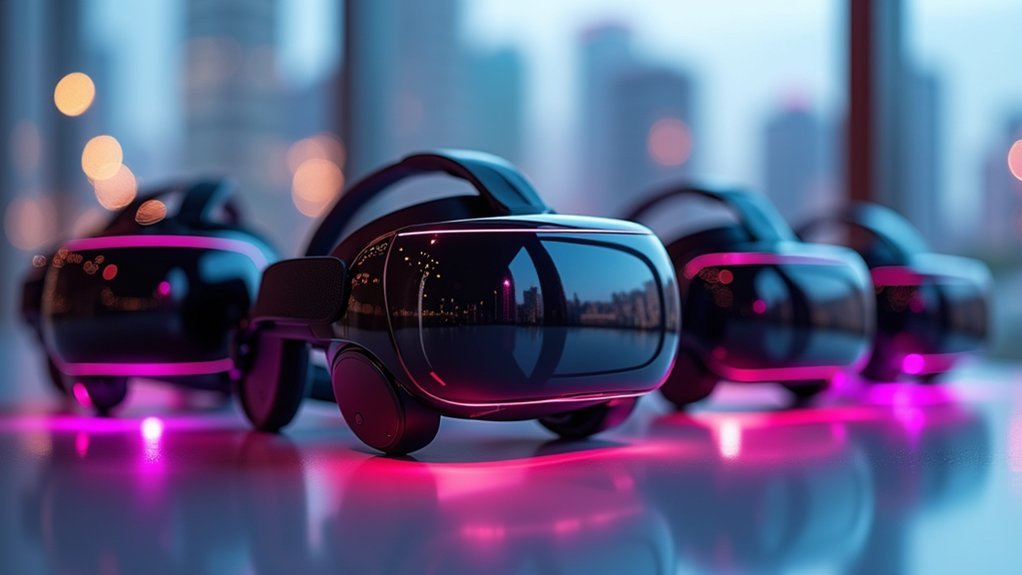The highest resolution VR headsets of 2023 include the Varjo XR-3 (70+ pixels per degree), HTC Vive Pro 2 (5K display with 2448×2448 per eye), Pimax 8K X (dual 4K displays), and HP Reverb G2 (2160×2160 per eye). You’ll need powerful hardware to run these premium headsets, with prices ranging from $600 to $6,000+. Each offers unique benefits beyond resolution, including field of view, comfort features, and mixed reality capabilities worth exploring further.
The Visual Revolution: Why Resolution Matters in VR

While many factors contribute to an immersive VR experience, resolution stands as the cornerstone of visual fidelity in virtual reality. When you put on a high-resolution headset, you’ll immediately notice the difference in visual clarity and detail, transforming how you perceive virtual environments.
Higher resolution eliminates the “screen door effect” that plagued earlier VR devices, allowing you to see textures, read text, and appreciate fine details that were previously blurred.
The crisp clarity of high-resolution VR vanquishes the screen door effect, revealing a world of previously invisible details.
This enhanced clarity doesn’t come without trade-offs, though. Your VR system needs more processing power to drive those extra pixels, which impacts both performance requirements and cost. The HTC Vive Pro 2 demonstrates this balance with its impressive 4896 x 2448 resolution per eye requiring substantial PC hardware.
Your brain processes these sharper visuals as more realistic, creating a stronger sense of presence and making your virtual adventures feel genuinely immersive.
HTC Vive Pro 2: Unpacking the 5K Experience
The HTC Vive Pro 2 epitomizes how resolution transforms VR experiences, offering an impressive 5K display that pushes visual boundaries.
With 2448 x 2448 pixels per eye and a 120-degree horizontal field of view, you’ll enjoy unprecedented peripheral vision and clarity.
This headset balances visual fidelity with comfort through adjustable IPD (57-70mm) and lens distance settings, accommodating glasses wearers and various head sizes.
The Hi-Res certified headphones deliver 3D spatial sound that perfectly complements the sharp visuals.
SteamVR Tracking 2.0 provides millimeter-precise 6DoF movement tracking across spaces up to 10m x 10m with four base stations.
For optimal performance in Full Resolution mode, you’ll need at least DisplayPort 1.4 with DSC technology on your PC.
Whether you’re designing architecture, training in simulations, or gaming, the Vive Pro 2’s 5K resolution dramatically reduces the screen-door effect, creating truly immersive virtual worlds.
Varjo XR-3: Photorealistic Visuals at 70+ PPD

Representing the absolute pinnacle of visual fidelity in VR headsets, Varjo’s XR-3 delivers an unmatched photorealistic experience with over 70 pixels per degree in its focal area. You’ll enjoy 1920 x 1920 resolution per eye in the focus area, while the peripheral vision offers 2880 x 2720 pixels, creating a seamless 115° field of view. The headset’s ultra-low latency of 20 ms ensures seamless virtual visualizations without disorienting lag.
| Feature | Specification | Benefit |
|---|---|---|
| Display | uOLED focal area | Crystal-clear visuals |
| Color Gamut | 99% sRGB, 93% DCI-P3 | True-to-life colors |
| Mixed Reality | 12MP pass-through + LiDAR | Perfect real-world integration |
The XR-3 Focal Edition takes things further with TAA/BAA compliance for military applications. With non-Fresnel lenses reducing eye strain and automatic IPD adjustment, you’ll experience unparalleled comfort during extended use in simulation, training, or design workflows.
HP Reverb G2: Affordable 4K Immersion
The HP Reverb G2 delivers exceptional visual clarity with its 2160×2160 per eye resolution, creating crisp 4K experiences without breaking the bank.
You’ll appreciate the balance between performance and affordability, with the headset supporting both SteamVR and Windows Mixed Reality platforms. The integrated spatial audio speakers enhance immersion with realistic 3D sound positioning.
Its combination of high-resolution LCD panels and 90Hz refresh rate guarantees you get impressive visuals while keeping costs lower than many competing premium headsets.
Visual Clarity Standout
Revered for its exceptional visual clarity, the HP Reverb G2 stands as a benchmark in affordable 4K VR technology. At €584 (excluding VAT), you’ll experience ultra-sharp 2160 x 2160 resolution per eye that outperforms many competitors in its class.
The G2’s visual experience is enhanced by:
- Mura-free LCD panels running at a smooth 90Hz refresh rate
- Expansive field of view (98-114° depending on sources)
- Integrated spatial audio for complete sensory immersion
- Precise 6 DoF tracking for natural movement
You’ll need at least an NVIDIA GTX 1060 or AMD RX 580 to power this visual powerhouse. The headset features impressively compact dimensions of 7.5 x 18.6 x 8.4 cm for its performance capabilities.
Whether you’re gaming, designing, or conducting professional training, the G2 delivers crystal-clear visuals with minimal system requirements and maximum comfort for extended sessions.
Budget Performance Balance
When balancing budget constraints with exceptional visual performance, the HP Reverb G2 emerges as a standout mid-tier option at €584 (excluding VAT).
You’ll get impressive 4K resolution (2160 x 2160 pixels per eye) without breaking the bank.
The headset delivers excellent value with its 90Hz refresh rate and 114-degree field of view, supported by a comfortable 500-gram design suitable for extended sessions.
While it doesn’t use Valve’s premium Lighthouse tracking, its 6DoF tracking system performs well in most environments thanks to four external cameras providing inside-out tracking capabilities.
You’ll need at least a GTX 1060 or RX 580 GPU to power this Windows Mixed Reality and SteamVR-compatible device.
For professionals and enthusiasts seeking high-resolution VR without premium pricing, the Reverb G2 offers the perfect compromise between visual fidelity and affordability.
Pimax 8K X: Wide FOV Meets Ultra-High Resolution

Standing at the frontier of VR display technology, Pimax’s 8K X headset delivers an impressive balance between ultra-wide field of view and crystal-clear resolution.
You’ll experience VR with unprecedented visual fidelity through dual 3840 x 2160 displays, totaling over 16 million pixels. The headset delivers these sharp visuals at a 75 Hz refresh rate for smoother motion during gameplay and virtual experiences.
- Expansive Visuals – Enjoy a massive 170-degree horizontal FOV that approaches human peripheral vision, creating unparalleled immersion.
- Native Resolution – Experience true 4K per eye without upscaling when paired with powerful GPUs.
- Versatile Connectivity – Connect via DisplayPort 1.2 with USB support for audio and tracking features.
- Customizable Comfort – Adjust the IPD between 55-75mm to match your exact eye spacing for ideal clarity and comfort.
HTC Vive Focus Series: Standalone High-Resolution VR
The HTC Vive Focus Series marks a significant leap in standalone VR technology, moving beyond PC-tethered systems like the Pimax 8K X.
These headsets deliver impressive visuals with the Focus 3 boasting a combined 4896 x 2448 resolution at a smooth 90Hz refresh rate.
The latest Focus Vision model takes performance further with Qualcomm’s Snapdragon XR2 processor, 12GB RAM, and advanced eye-tracking capabilities.
You’ll experience a generous 120-degree field of view and benefit from intuitive hand-tracking for natural interaction.
At $1,000 for consumers and €1,249 for business users, the Focus Vision targets both markets with its versatility.
The headset’s hot-swappable batteries, mixed reality support, and high-quality passthrough make it ideal for immersive simulations and multitasking applications without the constraints of cables.
Pre-orders include the valuable Vive Wired Streaming Kit for enhanced PC connectivity alongside seven bundled games.
The Technical Requirements Behind High-Resolution VR
High-resolution virtual reality demands substantial technological infrastructure to deliver the immersive experiences users expect. Your VR system needs powerful components working together seamlessly to prevent lag, blur, and motion sickness.
- Display Technology – You’ll need high-resolution screens (4K or higher) with fast refresh rates and quick response times, often utilizing Micro OLED for superior contrast. The best displays offer contrast ratios exceeding 100,000:1 for truly immersive visual depth.
- Graphics Processing – A robust GPU with at least 8GB memory (like NVIDIA RTX 3060 or better) is essential for rendering complex VR environments.
- System Requirements – Multi-core processors (Intel i7/i9) paired with ample RAM guarantee smooth operation in CPU-intensive applications.
- Connectivity Solutions – DisplayPort connections with compatible adapters and high-quality cables maintain signal integrity and minimize latency.
Resolution vs. Field of View: Finding the Perfect Balance
When selecting your next VR headset, you’ll face an important compromise between resolution and field of view that greatly impacts your immersive experience. Higher resolution provides sharper images and better clarity, while wider FOV lets you see more of the virtual world without turning your head.
The best balance hinges on pixels per degree—more pixels within your visible area means better image quality. Resolution is typically measured as width x height per eye, directly affecting image sharpness. Most high-end headsets aim for 110-120 degrees FOV for ideal viewing.
Lens technology, like the pancake lenses in Quest 3, plays a vital role in maintaining clarity across your field of vision. The position of lenses relative to your eyes affects perceived FOV, while the headset’s overall design must accommodate both factors to deliver the immersion you’re seeking.
Professional Applications for High-Resolution Headsets
Why are professionals increasingly turning to high-resolution VR headsets? The answer lies in their ability to transform complex tasks into intuitive experiences. Systems like Varjo VR-3, Vrgineers, and HTC Vive Pro 2 are revolutionizing how professionals work across industries.
- Training and Simulation – Military personnel and professionals master critical skills in risk-free environments with Vrgineers and Varjo headsets offering unparalleled visual fidelity.
- Design and Development – Companies like Kia Motors Europe leverage Varjo’s photorealistic displays for precise 3D modeling and product visualization. The VIVE Pro 2’s 5K resolution delivers the exceptional clarity necessary for detailed design visualization across multiple professional software platforms.
- Remote Collaboration – Pico 4 Ultra Enterprise enables multi-user environments where teams collaborate regardless of physical location.
- Software Integration – High-resolution headsets seamlessly connect with professional 3D applications, creating efficient workflows enhanced by features like hand tracking and LiDAR.
Gaming in Ultra-Clear VR: What to Expect
When you upgrade to an ultra-clear VR headset like the HTC Vive Pro 2 with its 4896 x 2448 per-eye resolution, you’ll immediately notice game environments transform from blocky approximations to crisp, detailed worlds.
The resolution difference makes textures pop with unprecedented clarity, allowing you to spot distant enemies or appreciate intricate design elements that lower-resolution headsets simply can’t display.
You’ll find that higher pixel counts not only make games more visually impressive but also reduce eye strain during longer gaming sessions, enabling you to stay immersed in virtual worlds for extended periods. VRcompare’s comprehensive database can help you compare these high-resolution specifications across multiple headset models.
Realistic Graphics Comparison
As today’s high-end VR headsets push the boundaries of visual fidelity, you’ll find significant differences in how various models render virtual worlds.
The Varjo XR-3 stands out with its unmatched 70+ pixels per degree, while Apple Vision Pro’s dual 4K Micro OLED displays deliver exceptional HDR quality that’s transforming immersive experiences. Meta Quest 3 offers impressive visuals with 2,064 by 2,208 pixels per eye, surpassing PlayStation VR2 for standalone headsets.
- Resolution Leaders: Varjo XR-3 offers the highest fidelity with photorealistic rendering, while Apple Vision Pro’s 3800×3000 per eye resolution creates stunningly crisp visuals.
- Field of View: HTC Vive Pro 2 provides a generous 120° FOV compared to narrower options on the Quest 3.
- Display Technology: Micro OLED (Vision Pro) versus LCD (Vive Pro 2) creates noticeable differences in color accuracy and contrast.
- Visual Clarity: Higher-end headsets deliver sharper text rendering and detailed textures that dramatically enhance immersion.
Resolution Impact Gaming
The breathtaking visual clarity of today’s high-resolution VR headsets comes with significant performance considerations for gaming enthusiasts. When you step into higher resolutions, you’ll need more powerful hardware to maintain smooth framerates, as your GPU must render two high-resolution images simultaneously.
This isn’t just about prettier visuals—higher resolutions enhance your depth perception and reveal gameplay details you’d otherwise miss. You’ll notice reduced eye strain during longer sessions, but you’ll also face increased VRAM usage and potentially higher reprojection rates. VR gaming demands more from your CPU because it processes double the draw calls compared to flatscreen gaming.
To experience ultra-clear VR gaming without compromises, you’ll need to invest in a capable GPU, sufficient RAM, and adequate cooling systems.
The performance scaling isn’t linear, so plan your upgrades carefully to balance the stunning visuals with the smooth performance essential for immersive VR gaming.
The Price of Clarity: Budget Considerations for Premium VR
Charting the vast landscape of VR headsets requires careful consideration of your budget and desired experience. The clarity you’ll enjoy directly correlates with what you’re willing to spend, with options ranging from $299 to over $3,000.
Navigating VR options means balancing your financial limits against your desired level of immersion and visual clarity.
- Entry-Level ($299-$399): Meta Quest 3S offers solid VR without breaking the bank—perfect for casual users and gamers who don’t need ultra-high resolution.
- Mid-Range ($400-$600): PSVR 2 and Meta Quest 3 deliver enhanced resolution and features, balancing performance with affordability. This segment has seen significant growth as manufacturers focus on price competition to attract mainstream consumers.
- High-End ($600-$1,000): HTC Vive Pro 2 and Meta Quest Pro provide premium resolutions above 3664 x 1920 for more immersive experiences.
- Ultra-Premium ($1,000+): Valve Index, Varjo Aero, and Apple Vision Pro ($3,499) deliver cutting-edge resolution, tracking, and design for enthusiasts and professionals.
Mixed Reality Capabilities in High-Resolution Headsets
Blending physical surroundings with digital elements, mixed reality capabilities have revolutionized high-resolution VR headsets in 2023. The Varjo XR-3 leads with an impressive 70 pixels per degree and 115-degree field of view, delivering photorealistic visuals through its 12-megapixel renderer.
You’ll find advanced sensor arrays in today’s premium headsets, with the HTC VIVE XR Elite featuring four wide-angle tracking cameras and a depth sensor that accurately maps your environment.
Meanwhile, the Meta Quest 3 leverages the Snapdragon XR2 Gen 2 processor to handle its 2064×2208 per-eye resolution while maintaining smooth performance. The upcoming Apple Vision Pro will elevate this category further with its exceptional HDR quality when it launches in early 2024.
These technological advancements have transformed applications across industries—from architectural visualization and medical training to immersive gaming experiences where virtual objects seamlessly interact with your physical space.
Future-Proofing Your VR Setup: Resolution Roadmap
As resolutions continue to climb dramatically in 2023’s premium headsets, forward-thinking VR enthusiasts need a clear roadmap for future investments.
With HTC Vive Pro 2 offering 4896 x 2448 pixels per eye and PSVR 2 delivering 2000 x 2040 PPE on OLED panels, resolution has become the primary consideration for 52% of consumers.
- Meta’s four planned headsets by 2024, including Project Cambria, will likely push resolution boundaries further.
- Apple’s secretive N301 headset aims to redefine expectations with rumored 8K displays.
- Advanced SoC processing power will become essential for handling increasingly detailed visuals.
- Future-proof investments should prioritize headsets with OLED panels for superior visual quality.
High-resolution VR headsets can significantly improve the user experience by enabling more realistic immersive experiences across gaming, healthcare, and automotive applications.
Your next headset purchase should balance current capabilities with technology that won’t feel outdated as resolution standards inevitably climb.
Comfort Features That Complement Crystal-Clear Displays
Crystal-clear displays mean nothing if you can’t wear your headset long enough to enjoy them.
You’ll appreciate how today’s VR headsets feature weight distribution innovations like the HTC Vive Pro 2’s improved ergonomics and the Varjo VR-3’s strap-knob system for fine-tuning comfort.
Extended wear solutions now include customizable face paths and adjustable lens positioning that conform to your unique facial structure, though these personalized comfort features may limit sharing your device with others.
Headset weight plays a significant role in comfort, with lighter options like the Oculus Quest 2 at 503g weight providing better extended usage experience than heavier competitors.
Ergonomic Design Elements
Comfort sits at the heart of modern VR headset design, transforming what was once a clunky technology into an extension of the user’s perceptual system.
Today’s headsets incorporate thoughtful engineering that keeps you immersed for hours without discomfort. High-end models like Varjo headsets offer automatic IPD adjustment for personalized visual optimization without manual configuration.
- Memory foam and gel padding contour to your facial features, while ventilated designs reduce heat buildup during intense sessions.
- Three-point precision fit headbands with multiple adjustment points accommodate various head shapes, ensuring stability without pressure points.
- Integrated cooling systems—both active fans and passive vent channels—maintain ideal temperature while preventing lens fogging.
- Ultra-wide, non-Fresnel lenses paired with high refresh rates (90+ Hz) dramatically reduce eye strain and motion sickness, keeping you comfortable in virtual worlds longer.
Weight Distribution Innovations
Weight distribution represents the next frontier in VR headset evolution, building upon the ergonomic foundations while addressing the persistent challenge of front-heavy designs.
You’ll notice this advancement in the Meta Quest 3, which employs pancake lens technology, creating a thinner profile that feels lighter than its predecessor despite a slight weight increase.
CES 2023 showcased numerous balanced headsets designed for extended gameplay sessions without discomfort.
The NXTWear V concept pushes boundaries further with its remarkable 236-gram weight.
Modern VR headsets now incorporate adjustable straps, advanced lightweight materials, and sophisticated weight distribution systems that evenly spread pressure across your head.
Razer’s new accessories for Meta Quest 2 specifically feature optimized weight distribution for improved balance during extended gameplay sessions.
These innovations aren’t merely about comfort—they directly enhance immersion by eliminating distractions, reducing eye strain, and making longer VR sessions possible while complementing the high-resolution displays that define premium headsets.
Extended Wear Solutions
The latest generation of VR headsets tackles the crucial challenge of extended wear comfort through innovative design elements that complement their high-resolution displays.
The HTC Vive XR Elite exemplifies this evolution with its modular design, allowing you to switch between full headset and lightweight goggle configurations based on your session duration. Premium facial interfaces with UltraSoft™ memory foam create an adaptive seal that prevents discomfort during long viewing sessions.
- Adjustable lens systems accommodate prescription needs and reduce eye strain—critical when you’re absorbing detailed visuals for hours.
- Advanced tracking systems create more natural interactions, making extended immersion feel less fatiguing.
- Swappable batteries provide up to 15 hours of continuous use without interrupting your experience.
- Ergonomic accessories like the Kontor system enhance comfort while preserving display quality by reducing light leakage.
These comfort innovations guarantee you can fully appreciate ultra-high resolution displays during marathon VR sessions.
Frequently Asked Questions
How Long Do High-Resolution VR Headset Batteries Typically Last?
You’ll typically get 2-3 hours of battery life from high-resolution VR headsets. Your usage time depends on factors like display resolution, processor efficiency, and whether you’re using power-saving features.
Are Prescription Lens Adapters Available for These Premium Headsets?
Yes, prescription lens adapters are available for premium VR headsets. You’ll find magnetic options from companies like VR Wave, VR Optician, and Reloptix that eliminate the need to wear glasses while using your headset.
Can These Headsets Be Used Effectively for Fitness Applications?
You’ll find high-resolution VR headsets excellent for fitness applications. They reduce motion sickness during workouts, provide immersive environments, and display detailed tutorials clearly. Many popular fitness apps like Supernatural and FitXR work wonderfully on them.
What Cleaning Methods Are Safe for High-Resolution VR Lenses?
For high-resolution VR lenses, you’ll want to use a dry microfiber cloth with gentle circular motions. Don’t use chemicals or alcohol wipes. Compressed air helps remove dust before wiping to prevent scratches.
How Do High-Resolution Headsets Perform in Bright Room Environments?
High-resolution headsets struggle in bright rooms due to their limited brightness (300-400 nits). You’ll see reduced contrast and color vibrancy. For best performance, you’ll want to use them in darker environments.
In Summary
When you’re ready to invest in premium VR, resolution should be your top priority. You’ll immediately notice the difference as text becomes readable and virtual worlds transform from pixelated environments to lifelike realities. While your budget will determine which headset fits your needs, any of these high-resolution leaders will future-proof your VR experience and deliver the visual clarity you’ve been waiting for.





Leave a Reply